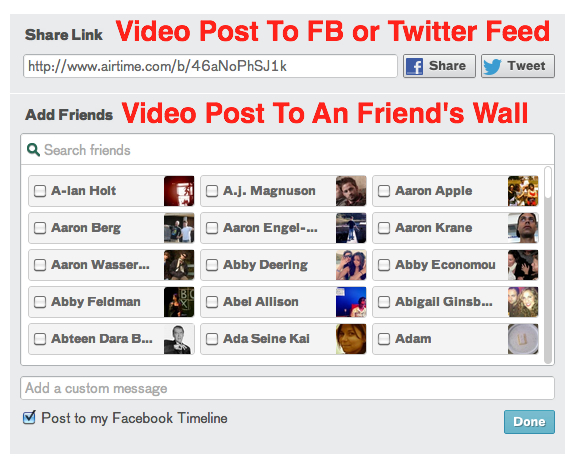Airtime planned to reach millions through real-time Facebook Chat invites to video calls. But private messages can’t go viral, so two months after launch it’s hoping for growth through public video posts to Twitter and Facebook. Since AppData shows Airtime as having just 1000 daily and 90,000 monthly actives, finding a distribution method that snowballs is crucial to the company making good on the $33.5 million fronted by its investors.
With this “limited public release” of video posts, its first Twitter integration, and an enhanced buddy list, Airtime users gain ways to tempt more friends to hop aboard, and not just one at a time.

Airtime probably would have liked to get this testing on the road soon after its debut June 6th. But glitches disrupted the flashy, celebrity-studded launch event and may have shook the team’s morale. Then it had to solidify the company’s organizational structure, and sort out who was in command after it acquired Erly just two weeks before launch.
If not for Sean Parker and Shawn Fanning, its celebrity founders, plus the big hyped launch and bigger warchest, there wouldn’t have been the same pressure on the company. But they shined a spotlight on Airtime, and made its lack of traction an easy target for criticism.

Airtime In The Main Stream
Now that it’s got its management situation sorted out, it can get back to typical startup business and iteration. Today’s release of video posts is a wise move. Before when you wanted to video call with a friend (and help Airtime gain users), you had to send them Facebook Chat message with an invite to meet up on Airtime. If that friend was busy, or couldn’t read your message until later when you’d sign off, you wouldn’t get connected and Airtime wouldn’t grow.
Now you can record a video post and share it to Twitter or Facebook, or post it directly to a Facebook friend’s wall. Then anyone at anytime can click through to view that video on Airtime. Oh, and sign up so they can leave a video response. You’ll also be greeted with a page of recent video posts and responses from friends whenever you log in.

 Friends Appear Out Of Thin Air
Friends Appear Out Of Thin Air
Meanwhile, the Airtime buddy list has been redesigned to help connect people with video call partners, and give them more to do when there’s no one around. Now instead of simply sorting by who’s online on Facebook right now, the buddy list is sorted into three categories of descending availability: People currently logged into Airtime, people currently on Facebook but not Airtime, and anyone else who is offline.
Searching the buddy list is faster now too, and clicking on a friend reveals your whole video call, video post, and text chat history. That means you can rewatch old posts while you’re waiting for them to respond to a real-time chat invite. And as always, you can let Airtime match you with a stranger based on your interests and location.
With new growth and retention mechanics, Airtime has a lot better chance of getting off the ground. And it’s got plenty of money to buy users if it can raise its viral coefficient. But there’s an ominous cloud blocking its sun.
People are busy. Text and image-focused sharing on Facebook and Twitter work so well because those are efficient mediums for publishing and consuming information. These social networks make it worthwhile to pop in for as little as 30 seconds, and if something’s boring or long-winded, you can scan right on to the next post.
Video is different. It has duration. These video posts could certainly give people a reason to take some quick Airtime, but not if they drag on like a voicemail. It might take a time limit, or an entirely new type of interaction, but the products needs to feel lightweight. Because if users think the minimum session takes too long, they’ll never see how Airtime could humanize the web through face-to-face interaction.
